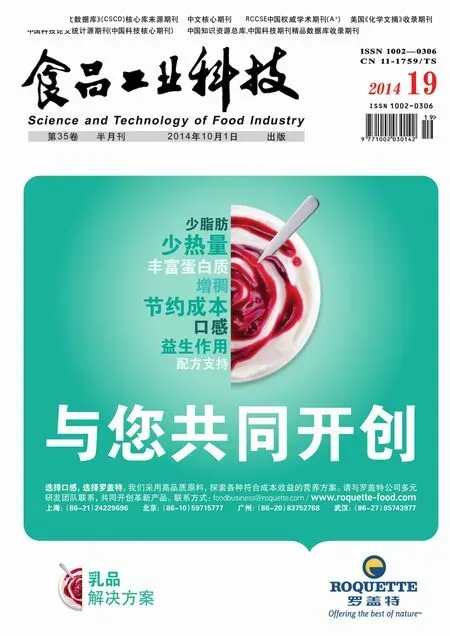射频(RF)热处理技术在果品贮藏中的应用
2014-12-04冯吉睿邓丽莉曾凯芳
冯吉睿,邓丽莉,曾凯芳,2,*
(1.西南大学食品科学学院,重庆 400715;2.农业部农产品贮藏保鲜质量安全风险评估实验室(重庆),重庆 400715)
近年来,采后热处理得以大力发展并应用于商业化处理果实。在传统的热水浸泡和热蒸汽处理的基础上,热处理技术的研究和应用快速发展,出现了射频(Radio frequency,RF)等新型的热处理方式。RF 是频率在 3KHz~300MHz 之间的电磁波[1-2]。美国联邦通信委员会 (FCC)允许 13.56,27.12 和40.68MHz 频率应用于工业,科学和医疗(ISM)[3]。RF热处理作为一种高效的介电热处理方式应用于食品工业已有多年。由于RF热处理具有体积加热、加热速率可调和能源利用率高等特点,在食品解冻和饼干烘烤后的调节等方面已经体现出它的优势[4-5]。前人已经综述了 RF热处理技术在肉品加工、液体食品加热等方面的应用,并提出RF技术用于食品加工和保存的重大工程挑战,同时也讨论了设计这类系统数学模型的潜在用途[6-7]。近些年来,已经有越来越多的工作集中在RF热处理技术在果蔬贮藏中的应用,本论文主要从RF热处理技术对果蔬病虫害的控制和对贮藏品质的影响,以及RF热处理技术的加热不均匀性问题的研究进行了综述。
1 RF热处理技术对干果虫害和病害的控制效果
虫害是影响国内外干果(葡萄干,红枣,杏,无花果,西梅等)贸易最重要的卫生检疫指标[8]。一般干果的介电损耗因子ε″较害虫的小得多,因此干果在RF热处理下吸热升温的速度比害虫慢,或者处在磁场中相同时间温度低许多。再者害虫比干果具有更高的含水量,害虫将吸收比干果多的RF能量,达到比周围的食品较高的温度以致被杀死。由于处理时间短,RF热处理可以保证杀灭害虫的同时使干果品质符合合格安全的要求[9-10]。研究表明,27MHz 下RF的穿透深度可用于开发采后杀虫的工业化RF热处理设备[11-12]。
在27MHz RF下,核桃中害虫升温速度至少是核桃升温的1.3倍,所以能够在杀死害虫的同时保证核桃的品质[13]。Wang 等[14-15]提出了设计和扩大核桃采后杀虫RF处理规模的工艺流程,这种工艺流程拥有高功率(25kW)和高负载的产品量(187kg的产品在皮带上移动)。商业化RF热处理核桃过程受多种因素影响,如核桃方向、开放式和封闭式外壳的核桃之间的不均匀加热,以及实际存储能量和能源消耗等。Mitcham等[16]在处理核桃的装置上负载一个RF施加器(27MHz,12kW),加热核桃至55℃或更高时,发现第五龄的脐橙螟(Amyelois transitella)的死亡率为100%。
吴晓玲[17]和 Guo[18]等的研究表明在一定的温度下,RF频率低于100MHz时,板栗象鼻虫的损耗因子远远高于板栗,即在同一磁场中,电磁波对栗实象甲有选择性加热。在27MHz下板栗穿透深度最小为11.6cm。选择性加热板栗象鼻虫和RF的穿透深度表明,在10MHz和100MHz之间的RF热处理比微波(MW)热处理对控制栗子害虫更实用。
由于害虫如印度谷螟(Plodia interpunctella)和脐橙螟(Amyelois transitella)的介电损耗因子比干果的大26~36倍,所以RF热处理在杀虫中具有巨大的潜力。用含水量在15~30.2g/100g的葡萄干,红枣,杏干,无花果和西梅做材料,其在27MHz RF下的穿透深度(28.4~103.7cm)在连续和大规模处理控制干果采后虫害中有发展潜力[19]。用RF热处理杏仁杀虫时,轻微的优先加热将提高大规模 RF处理的效率[20]。
生杏仁很容易遭受致病细菌如沙门氏菌的污染。流行病学和环境调查确认杏仁遭受致病菌污染主要发生在收获后倒在地上和干燥过程中的机械摇动[21]。杏仁壳是多孔的,使用传统的热处理方法(如强制热风)热传导效果不佳,MW和RF处理可解决这一问题。Gao等[22]发现杏仁水分活度降低提高了沙门氏菌热阻性,故在RF处理之前增加浸泡过程可以降低沙门氏菌的侵染率。含水量在23%左右的杏仁在75℃以上的高温下RF热处理2~4min,能够杀灭沙门氏菌并不影响产品的品质。此外,另一研究表明在每一个相应的温度和湿度,RF(27MHz和40MHz)的穿透深度约是微波频率(915MHz和1800MHz)的6~24倍,故RF热处理是一种能够加热均匀、处理规模大且有效控制沙门氏菌污染的干燥生杏仁的方法[23]。
综上所述,RF加热技术可以在保证核桃、板栗、生杏仁等干果品质的前提下杀灭害虫。说明RF加热技术是杀灭干果害虫有效的方法之一。
2 RF热处理技术对鲜果虫害及贮藏品质的影响
由于RF热处理具有快速和体积加热特性,其用于水果灭虫有利于克服传统热处理方法引起的水果品质变化。Birla等[24]对RF热处理灭虫后的柑橘的品质(包括失重、硬度、颜色变化、可溶性总固形物、酸及挥发物的变化等)进行了检测,在4℃贮藏10d后,发现除了挥发性物质有显著的变化外,其他指标均无显著变化(p<0.05)。在盐水中 RF热处理果实,温度从19℃升至48℃,然后在48℃保持15min,这样处理不仅符合检疫安全还不损害处理后柑橘的品质。樱桃果实采用热水预热处理至38℃再用RF热处理到 53℃ 保持 1.5min或 54℃ 保持 1min能100%的杀死内蠹蛾(Cydiapomonella[L.])幼虫,即使在52℃保持4min也能保证检疫安全,处理后在模拟空运(5℃,24 h)贮运时,仍能保持樱桃的色泽,不会引起果皮皱缩和腐烂,仅对果肉褐变有轻微的影响[25]。
Wang等[26]发现将新鲜苹果放在45℃热水中预热处理30min,再利用12kW、27.12MHz RF热处理至48℃保持15min能杀灭苹果上的内蠹蛾,处理过的果实在4℃下贮藏30d后还能很好的保持果实的硬度、色泽可溶性固形物和可滴定酸。Sosa-Morales等[27-28]利用热处理和RF热处理相结合的方法对未成熟芒果和其害虫墨西哥果蝇(Anastrepha ludens)进行了处理,结果发现利用热水(45℃)热处理50min,然后在27.12MHz,12kW RF 设备下处理 1min,直到整个果实的温度达到48℃后,在该温度的热水中分别保持4、6、8min,三龄幼虫可达到100%的死亡率。该处理方法与美国农业部动物卫生检验局(USDAAPHIS)采用的传统热处理(46.1℃热水处理90min)相比,两者都在21℃,湿度90%的条件下贮藏12d后,前者处理后的芒果果实更加坚硬,可以说明与传统热处理法相比RF处理后可以改进水果的质地结构。RF处理后使水果在48℃下保持6、8min,可达到规定的检疫安全,而不会造成果实品质受损。
由于不同水果的介电性质都不同,对RF的反应也明显不同。水辅助RF热处理是一个替代化学熏蒸的潜在方法,可用于杀死墨西哥果蝇(Anastrepha ludens)保证‘Fuyu’柿子检疫安全。Tiwari等[29]用热水预热处理‘Fuyu’柿子至40℃,在经过RF处理加热至48℃保持8min能杀死果实上的墨西哥果蝇(Anastrepha ludens),贮藏7d(室温和4℃)对果实的失重率、硬度、可溶性固形物和可滴定酸度没有显著的影响,只是花萼有轻微的褐变。Monzon等[30]评估RF热处理用于控制‘Fuyu’柿子的墨西哥果蝇幼虫的影响,发现处理方法(48~52℃保持 0.5~18min)没有显著影响果实的硬度、可溶性固形物含量,可滴定酸和失重,与对照相比RF处理后果实的果皮橙红色更深。Hansen等[31]发现在RF下处理29min再用脉冲在50℃下处理5min,能控制苹果内蠹蛾幼虫并增强水果的热处理均匀性,但是严重影响了苹果的贮藏品质。
由于RF处理对果实的品质影响好坏参半,因此在应用RF热处理杀虫时首先要保证果实的基本品质和屏蔽水果组织中的有害热效应。
3 RF热处理技术对鲜果贮藏病害的防治
鲜有资料报道RF热处理技术用于鲜果采后病害的控制。与热水处理和热空气处理相比,RF热处理能够直接使果实内部升温,杀灭潜伏在果实内部的病原菌,更容易控制采后潜伏性侵染性病害。Casals等[32]用RF处理桃和油桃18min来控制褐腐病,结果表明RF能有效控制桃褐腐病的发生,但不适合用于油桃褐腐病控制。此外,在以往的研究中发现果实大小影响RF处理的效果。因此,实验需要解决处理油桃的时间和加热的不均匀这两大问题。
Sisquella 等[33]利用27.12MHz的 RF 热处理设备在热水和空气中处理桃子和油桃来控制褐腐菌(Monilinia spp.)引起的褐腐病。结果发现果实在20℃的水中用RF处理9min显著降低了果实褐腐病的发病率;在空气中用RF处理果实18min,桃的发病率显著低于油桃的。最后研究了不同处理时间和不同水温对发病率的影响,结果表明利用27.12MHz的RF热处理设备在35℃的热水中处理6min和40℃处理4.5min能抑制褐腐病的发生且不影响果实的品质。然而,更多的研究需要探讨在其他的条件下的RF处理效果,因为病原体对热的反应受多种因素的影响如病菌感染时间,接种量,孢子含水率和果实成熟度等[34]。
4 展望
介电常数影响电磁波的在材料界面的反射和材料内能量的衰减。复杂材料的相对介电常数 ε*=ε′-jε″(j=(-1)0.5)包括介电常数 ε′(其表示当材料暴露于电场中的能量存储)和介电损耗因子ε″(影响对能量吸收和衰减)。RF加热农产品时,RF能量的吸收与损耗因子成正比,因此,不同的农产品接触到RF场时其加热也不尽相同[35]。频率,温度,盐含量,水分含量、水分的状态(冻结,束缚或自由)和食品内容物(比如脂肪)是影响农产品和生物材料介电性能的主要因素[3,36-37]。在射频范围内,介电损耗因子主要由离子导电性影响[38]。在水中加盐增加了离子导电率和介质的损耗因子。在RF加热下,通过添加食盐可以克服水果在水中不均匀加热,盐的添加量取决于水果的介电常数[39]。因此,水果的介电常数是设计射频加热过程中必不可少的信息。
加热不均匀性是影响开发RF热处理控制虫害和其他应用过程中最主要的问题之一。热处理不均匀会造成角,边缘和中心部分过热,在中高含水量的食物中尤为明显[40-41]。这种温度变化降低了处理的效率,也可能对产品造成严重的热损伤,影响产品的品质。Birla等[42]用 FEMLAB 研究了在 12kW,27.12MHz的 RF系统中鲜果的热处理不均匀性,发现鲜果果实的尺寸,几何形状和介电性质是引起鲜果RF热处理不均匀的主要因素,果皮和果肉的介电常数不同也能极大地影响水果的RF热处理效果。Wang等[43]研究RF处理防治农产品病虫害时发现小尺寸的农产品比大尺寸的热处理均匀性好。由于不同的水果对RF有明显不同的反应,所以应用RF对水果的灭虫应该依据不同的产品来进行设计处理方法。
目前,已经有很多研究证实可以帮助解决加热不均匀的问题,如利用计算机和商业的数据处理软件(如COMSOL,FEMLAB等软件)来模拟RF处理食品,分析在食品材料中RF能量的分布,解释复杂的RF热处理过程,预测干燥食品材料中的温度分布[44]。RF热处理还可以应用于水果采后侵染性病害的防治,可以将RF热处理和热盐水处理、生物防治结合应用,研发一种更好的病害防治方法。并且鉴于RF热处理技术有高效无污染,安全,易操作等优势,该技术仍然值得深入探索。随着技术的进步和深入研究的开展,RF热处理技术在果品贮藏具有广阔的应用前景。
[1]Marra F,Zhang L,Lyng J G.Radio frequency treatment of foods:Review ofrecentadvances[J].JournalofFood Engineering,2009,91:497-508.
[2]Ramaswamy H,Tang J.Microwave and radio frequency heating[J].Food Science and Technology International,2008,14(5):423-427.
[3]Tang J.Dielectric properties of foods[M]//Schubert H,Regier M.The Microwave Processing of Foods.UK:The Microwave Processing of Foods,2005.
[4]Farag K W,Lyng J G,Morgan D J,et al.A comparison of conventional and radio frequency thawing of beef meats:effects on product temperaturedistribution[J].Food and Bioprocess Technology,2011,4(7):1128-1136.
[5]Palazoglu T K,Coskun Y,Kocadagli T,et al.Effect of radio frequency postdrying of partially baked cookies on acrylamide content,texture,and color of the final product[J].Journal of Food Science,2012,77(5):E113-E117.
[6]Zhao Y,Flugstad B,Kolbe E,et al.Using capacitive(radio frequency)dielectric heating in food processing and preservation-a review[J].Journal of Food Process Engineering,2000,23:25-55.
[7]Wang Yunyang,Li Yuanrui,Wang S,et al.Review of dielectric drying of foods and agricultural products[J].International Agricultural Engineering Journal,2011,4(1):1-19.
[8]Johnson J A,Yahia E M,Brandl D G.Dried fruits and tree nuts[M].Florida:CRC Press,2009:507-526.
[9]Wang S,Tang J.Radio frequency and microwave alternative treatments for nut insect control:a review[J].International Agricultural Engineering Journal,2001,10:105-120.
[10]Wang S,Tang J,Johnson J A,et al.Dielectric properties of fruits and insect pests as related to radio frequency and microwave treatments[J].Biosystems Engineering,2003,85(2),201-212.
[11]Guo W,Tiwari G,Tang J,et al.Frequency,moisture and temperature-dependent dielectric properties of chickpea flour[J].Biosystems Engineering,2008,101(2):217-224.
[12]Guo W,Tiwari G,Wang S,et al.Temperature and moisture dependent dielectric properties of legume flour associated with dielectric heating[J].LWT-Food Science and Technology,2010,43(2):193-201.
[13]Wang S,Tang J,Cavalieri R P,et al.Differential heating of insects in dried nuts and fruits associated with radio frequency and microwave treatments[J].Transactions of the ASAE,2003,46(4):1175-1182.
[14]Wang S,Tang J,Sun T,et al.Consideration in design of commercial radio frequency treatments for postharvest pest control in in- shell walnuts[J].Journal of Food Engineering,2006,77(2):304-312.
[15]Wang S,Monzon M,Johnson J A,et al.Industrial-scale radio frequency treatments for insect control in walnuts I:heating uniformity and energy efficiency[J].Postharvest Biology and Technology,2007,45:240-246.
[16]Wang S,Monzon M,Johnson J A,et al.Industrial-scale radio frequency treatments for insect control in walnutsⅡ:insect mortality and product quality[J].Postharvest Biology and Technology,2007,45:247-253.
[17]吴晓玲.板栗和榛子及其目标害虫RF/微波介电特性的研究[D].杨凌:西北农林科技大学,2012.
[18]Guo Wenchuan,Wu Xiaoling,Zhu Xinhua,et al.Temperature-dependent permittivities of chestnut and chestnut weevil from 10 to 4500 MHz[J].Biosystems Engineering,2011,110(3):340-347.
[19]AlfaifiB,WangS,TangJ,etal.Radiofrequency disinfestation treatments for dried fruit:Dielectric properties[J].Food Science and Technology,2013,50:746-754.
[20]Wang S,Tang J,Johnson J A,et al.Heating uniformity and differential heating of insects in almonds associated with radio frequency energy[J].Journal of Stored Products Research,2013,55:15-20.
[21]Isaacs S,Aramini J,Ceibin B,et al.An international outbreak of salmonellosis associated with raw almonds contaminated with a rare phage type of Salmonella Enteritidis[J].Journal of Food Protection,2005,68:191-198.
[22]Gao M,Tang J,Villa-rojas R,et al.Pasteurization process development for controlling Salmonella in in-shell almonds using radio frequency energy[J].Journal of Food Engineering,2011,104(2):299-306.
[23]Gao M,Tang J,Johnson J A,et al.Dielectric properties of ground almond shells in the development of radio frequency and microwave pasteurization[J].Journal of Food Engineering,2012,112:282-287.
[24]Birla S L,Wang S,Tang J,et al.Quality of oranges as influenced by potential radio frequency heat treatments against Mediterranean fruit flies[J].Postharvest Biology and Technology,2005,38:66-79.
[25]Monzon M E,Biasi B,Simpson T L,et al.Effect of radio frequency heating as a potential quarantine treatment on the quality of Bing sweet cherry fruit and mortality of codling moth larvae[J].Postharvest Biology and Technology,2006,40:197-203.
[26]Wang S,Birla S L,Tang J,et al.Postharvest treatment to control codling moth in fresh apples using water assisted radio frequency heating[J].Postharvest Biology and Technology,2006,40:89-96.
[27]Sosa- morales M E,Tiwari G,Wang S,et al.Dielectric heating as a potential post-harvest treatment of disinfesting mangoes.I:Relation between dielectric properties and ripening[J].Biosystems Engineering,2009,103(3):297-303.
[28]Sosa- morales M E,Tiwari G,Wang S,et al.Dielectric heating as a potential post-harvest treatment of disinfesting mangoes,PartⅡ:Development of RF-based protocols and quality evaluation of treated fruits[J].Biosystems Engineering,2009,103(3):287-296.
[29]Tiwari G,Wang S,Birla S L,et al.Effect of water- assisted radio frequency heat treatment on the quality of‘Fuyu’persimmons[J].Biosystems engineering,2008,100:227-234.
[30]Monzon M E,Biasi B,Mitcham E J,et al.Effect of radiofrequency heating on the quality of Fuyu persimmon fruits a treatment for control of the Mexican fruit fly[J].Hot Science,2007,42(1):125-129.
[31]Hansen J D,Drake S R,Watkins M A,et al.Radio frequency pulse application for heating uniformity in postharvest codling moth(lepidoptera:tortricidae)control of fresh apples(malus domestica borkh.)[J].Journal of Food Quality,2006,29:492-504.
[32]Casals C,Landl A,Picouet P,et al.Application of radio frequency heating to control brown rot on peaches and nectarines[J].Postharvest Biology and Technology,2010,58:218-224.
[33]Sisquellaa M,Casals C,Picouet P,et al.Immersion of fruit in water to improve radio frequency treatment to control brown rot in stone fruit[J].Postharvest Biology and Technology,2013,80:31-36.
[34]Barkai-golan R,Phillaps D J.Postharvest heat treatment of fresh fruits and vegetables for decay control[J].Plant Diseases,1991,75:1085-1089.
[35] Ryynänen S.The electromagnetic properties offood materials:a review of the basic principles[J].Journal of Food Engineering,1995,29:409-429.
[36]Nelson S O.Frequency and moisture dependence of the dielectric properties of high- moisture corn[J].Journal of Microwave Power and Electromagnetic Energy,1978,13(2):213-218.
[37] Ryynanen S.The electromagnetic properties offood materials:a review of the basic principles[J].Journal of Food Engineering,1995,26(4):409-429.
[38]Guan D,Cheng M,Wang Y,et al.Dielectric properties of mashed potatoes relevant to microwave and radio-frequency pasteurization and sterilization processes[J].Journal of Food Science,2004,69(1):E30-E37.
[39]Ikediala J N,Hansen J D,Tang J,et al.Development of a saline water immersion technique with RF energy as a postharvest treatment against coding moth in cherries[J].Postharvest Biology and Technology,2002:24,25-37.
[40]Zhao Y,Flugstad B,Kolbe E,et al.Using capacitive(radio frequency)dielectric heating in food processing and preservation)a review[J].Journal of Food Process Engineering,1999,23(1):25-55.
[41]Tang J,Chan TV C T.Microwave and radio frequency in sterilization and pasteurization applications[M].Southampton:WIT Press,2007:102-157.
[42]Birla S L,Wang S,Tang J,et al.Characterization of radio frequency heating of fresh fruits influenced by dielectric properties[J].Journal of Food Engineering,2008,89:390-398.
[43]Wang S,Yue J,Chen B,et al.Treatment design of radio frequency heating based on insect control and product quality[J].Postharvest Biology and Technology,2008,49:417-423.
[44]Tiwari G,Wang S,Tang J,et al.Computer simulation model development and validation of radio frequency(RF)heating of dry food materials[J].JournalofFood Engineering,2011,105:48-55.
